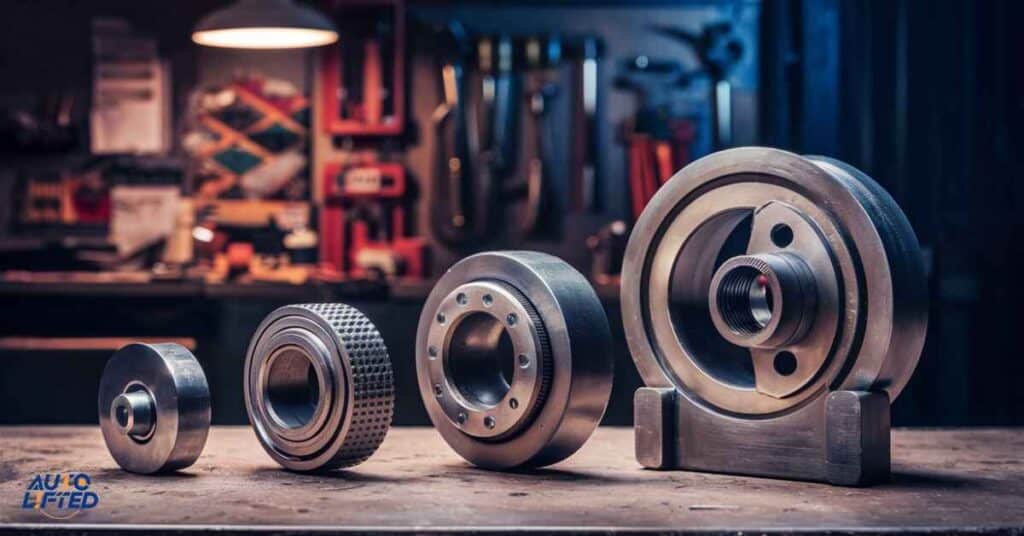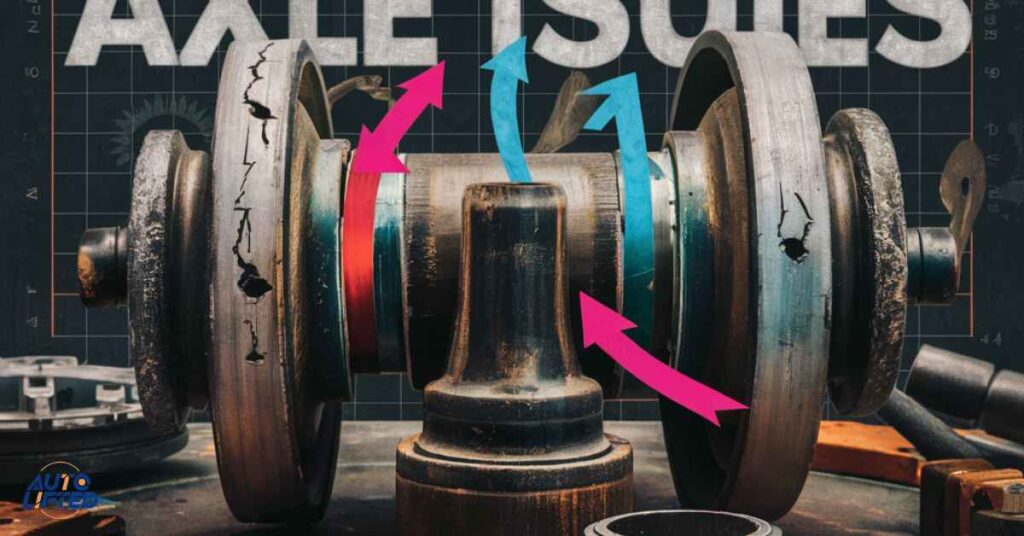Understanding the anatomy of a car is essential for vehicle maintenance and operation. One crucial aspect is the number of axles a car possesses. Typically, a car has two axles: the front axle and the rear axle.
These axles are responsible for connecting the wheels to the vehicle’s body and transmitting power from the engine to the wheels. By knowing how many axles a car has, drivers and mechanics can better understand its structure and functionality, facilitating maintenance and repairs as needed.
Types of Car Axles

Types of car axles play a pivotal role in the functionality and performance of a vehicle. Here are the key types:
Rear Axle: Positioned at the rear of the vehicle, it transmits power from the differential to the rear wheels.
Front Axle: Located at the front of the vehicle, it supports the front wheels and assists in steering.
Stub Axle: Commonly found in older vehicles or certain types of trailers, it connects the wheel hub to the suspension system.
Understanding these axle types is crucial for vehicle maintenance and repair, as each serves a distinct function in ensuring smooth and safe operation on the road.
Read This Blog:
Does costco install car batteries?
Types of Floating Axles

Floating axles come in various configurations, each offering unique benefits. Here are the main types:
Semi-Floating Axle: This type supports the weight of the vehicle on the axle shaft itself. It is commonly used in rear-wheel-drive vehicles and is more cost-effective than a full-floating axle.
Full-Floating Axle: In this design, the weight of the vehicle is supported by the axle housing, not the axle shaft. This enhances load-carrying capacity and allows for easier maintenance of wheel bearings.
Three-Quarter Floating Axle: This axle type combines features of both semi-floating and full-floating axles. It provides improved load-bearing capabilities compared to a semi-floating axle while retaining some of the cost benefits.
Each type of floating axle has its advantages, catering to different vehicle requirements and operating conditions. Understanding these variations is essential for selecting the appropriate axle type for a vehicle’s needs.
Common Vehicle Axle Configurations:

Common vehicle axle configurations vary depending on the vehicle’s design and purpose. Here are four typical setups:
2-Axle Vehicle: This configuration is standard in most cars and consists of two axles—one at the front and one at the rear—each supporting two wheels.
4-Axle Vehicle: Commonly seen in heavy-duty trucks or specialized vehicles, this setup includes four axles, typically with two axles at the front and two at the rear, providing enhanced load-bearing capacity.
Single-Axle Vehicle: Found in smaller vehicles like motorcycles or bicycles, this setup has only one axle supporting both wheels.
3-Axle Vehicle: Often seen in larger trucks or trailers, this configuration includes three axles—two at the rear and one at the front—to distribute weight and improve stability when carrying heavy loads.
Understanding these axle configurations is essential for vehicle design, maintenance, and operation, as they directly impact factors such as load capacity, maneuverability, and stability.
Understanding Car Axles
Car axles are crucial components that connect the wheels to the vehicle’s body and facilitate motion. Understanding them is essential for vehicle maintenance and operation. Typically, cars have two main types of axles: front and rear.
The front axle supports the front wheels and assists in steering, while the rear axle transmits power from the differential to the rear wheels. Additionally, some vehicles may have stub axles, which connect the wheel hub to the suspension system.
By grasping the role of each axle, drivers and mechanics can better comprehend a vehicle’s structure and functionality, aiding in maintenance and repairs as needed.
Factors Determining Axle Types
Vehicle Design: The overall design of the vehicle, including its size, weight distribution, and intended use, determines the axle configuration. For example, trucks carrying heavy loads may require stronger axles than compact cars.
Drive Configuration: Whether a vehicle is front-wheel drive, rear-wheel drive, or all-wheel drive affects the axle layout. Different drive configurations may require unique axle designs to accommodate power transmission to the wheels.
Suspension Type: The type of suspension system employed—such as independent or solid axle suspension—affects the axle requirements. Each suspension type has specific axle mounting and articulation needs.
Terrain and Usage: Vehicles designed for off-road or rugged terrain may require specialized axles with increased ground clearance and durability to withstand harsh conditions.
Cost and Manufacturing Considerations: Cost-effectiveness and ease of manufacturing also influence axle choices. Manufacturers seek to balance performance with production costs to meet market demands effectively.
Regulatory Requirements: Compliance with safety and environmental regulations may dictate axle specifications, particularly in terms of load capacity and emissions standards.
By considering these factors, vehicle manufacturers can determine the most suitable axle types to optimize performance, durability, and safety for various vehicle applications.
Also Read This Blog:
Are buicks good cars?
Identifying Axle Issues:

Identifying axle issues is crucial for maintaining vehicle safety and performance. Here are common signs of axle problems:
Unusual Noises: Grinding, clicking, or popping noises when turning or driving straight may indicate worn or damaged axle components.
Vibration: Excessive vibration, especially at certain speeds or during acceleration, could signal issues with axle shafts or CV joints.
Uneven Tire Wear: Uneven tire wear, such as bald spots or irregular tread patterns, may result from misaligned or damaged axles.
Fluid Leaks: Leaking axle seals or differential fluid can indicate axle seal failure or other internal issues.
Axle Shaft Movement: Excessive play or movement in the axle shafts or CV joints can indicate wear or damage.
Vehicle Pulling: If the vehicle pulls to one side while driving, it could indicate axle misalignment or damage.
ABS Warning Light: A lit ABS warning light may indicate issues with wheel speed sensors, which are integral to axle performance in vehicles with ABS systems.
Promptly addressing these signs of axle issues can prevent further damage and ensure safe operation of the vehicle. Regular inspections and maintenance are essential for detecting and resolving axle problems before they escalate.
Signs of Axle Wear and Tear
Signs of axle wear and tear can indicate potential issues that need attention. Here’s what to look for:
Clicking or Clunking Noises: Strange noises, especially when turning or accelerating, could suggest worn-out CV joints or failing axle components.
Vibration: Excessive vibration, particularly at higher speeds, may indicate imbalanced or damaged axles.
Uneven Tire Wear: Irregular tire wear patterns, such as excessive wear on one side of the tire, can result from misaligned or damaged axles.
Fluid Leaks: Leaking axle seals or differential fluid can indicate axle seal failure or other internal issues.
Loose or Wobbly Wheels: If you notice play or movement in the wheels when lifted off the ground, it could signal worn or damaged axle bearings.
Vehicle Drift or Pull: A tendency for the vehicle to drift or pull to one side while driving could indicate axle misalignment or damage.
ABS Warning Light: A lit ABS warning light may indicate issues with wheel speed sensors, which are integral to axle performance in vehicles equipped with ABS systems.
Addressing these signs promptly can prevent further damage and ensure safe driving conditions. Regular inspections and maintenance are essential for detecting and resolving axle wear and tear issues before they escalate.
Miscellaneous:
In a miscellaneous section related to car axles, you might include information on:
Axle Maintenance: Tips for maintaining axles, such as regular inspections, lubrication, and addressing issues promptly to prevent costly repairs.
Upgrading Axles: Information on upgrading axles for improved performance, such as swapping to aftermarket axles with higher load capacities or better off-road capabilities.
Axle Swaps: Details on swapping axles for customization purposes, including considerations for compatibility, modifications needed, and potential performance enhancements.
Axle Repair Costs: General information on the costs associated with axle repairs or replacements, including factors that can affect pricing and tips for budgeting.
Axle Safety: Important safety considerations related to axles, such as avoiding overloading, maintaining proper alignment, and recognizing signs of axle failure.
Including these miscellaneous topics can provide valuable insights for readers seeking comprehensive information on car axles and their maintenance.
Differences in Drive Types
Understanding the differences in drive types is essential for selecting the right vehicle for your needs. Here are the main variations:
Front-Wheel Drive (FWD): In FWD vehicles, power is transmitted to the front wheels, which are responsible for both propulsion and steering. This layout typically offers better traction in slippery conditions and improved fuel efficiency.
Rear-Wheel Drive (RWD): RWD vehicles deliver power to the rear wheels, providing a more balanced weight distribution and better handling, especially in performance-oriented cars. RWD is commonly found in trucks and sports cars.
All-Wheel Drive (AWD): AWD systems distribute power to all four wheels, automatically adjusting traction to each wheel as needed. AWD provides enhanced stability and traction in various road conditions, making it popular in SUVs and performance vehicles.
Four-Wheel Drive (4WD): 4WD vehicles are designed for off-road use, allowing the driver to manually engage all four wheels for maximum traction. Unlike AWD, 4WD typically requires driver input to activate and deactivate, and it excels in rugged terrain and adverse weather conditions.
Understanding the characteristics and capabilities of each drive type can help you make an informed decision when choosing a vehicle that best suits your driving needs and preferences.
Torque vs. Horsepower
Understanding the difference between torque and horsepower is essential for evaluating a vehicle’s performance. Here’s a breakdown of each:
Torque: Torque is the rotational force produced by the engine, typically measured in pound-feet (lb-ft) or Newton-meters (Nm). It determines a vehicle’s ability to accelerate and tow heavy loads, with higher torque values indicating stronger pulling power.
Horsepower: Horsepower is a measure of an engine’s work output over time, indicating how quickly work can be done. It combines torque with engine speed (RPM) and is commonly measured in horsepower (hp) or kilowatts (kW). Higher horsepower values reflect greater overall engine performance and higher top speeds.
While torque provides the initial thrust for acceleration, horsepower determines a vehicle’s overall speed and performance capabilities. Understanding the balance between torque and horsepower is crucial for assessing a vehicle’s suitability for specific driving conditions and tasks.
Frequently Asked Question
Do cars have 4 axles?
No, cars typically have either two or three axles, depending on the vehicle type and configuration.
Does a car have 1 or 2 axles?
Most cars have two axles—one at the front and one at the rear—to support the four wheels.
How many axles does a vehicle have?
The number of axles in a vehicle varies; it can range from one axle in motorcycles to multiple axles in trucks or trailers.
What is a 3 axle vehicle?
A 3 axle vehicle typically refers to a vehicle with three sets of axles, commonly seen in larger trucks or buses.
Does 4×4 have 2 axles?
Yes, a 4×4 vehicle typically has two axles—one at the front and one at the rear—each with two sets of wheels powered by the engine.
Does a 4×4 have 4 axles?
No, a 4×4 vehicle has two axles, but each axle typically has two sets of wheels, resulting in a total of four powered wheels.
How many axles does a Toyota Corolla have?
A Toyota Corolla typically has two axles—one at the front and one at the rear—to support its four wheels.
Final Thoughts
The number of axles a car has typically varies depending on its design and configuration. Most cars are equipped with either two or three axles to support the vehicle’s weight and facilitate motion. Two-axle cars feature one axle at the front and one at the rear, each supporting two wheels.
Three-axle cars may include an additional axle to accommodate heavier loads or specialized functions. Understanding the number of axles in a car is essential for various purposes, including vehicle maintenance, operation, and regulatory compliance.
By grasping this fundamental aspect of automotive engineering, drivers and enthusiasts can gain insights into a vehicle’s structure and functionality, enabling them to make informed decisions regarding performance, safety, and suitability for specific tasks or driving conditions.







